Interesting Facts About Machu Picchu You Never Knew
Did you know Machu Picchu's engineering marvels extend beyond its breathtaking location? The Inca city's precise stonework, using the ashlar technique, creates earthquake-resistant structures without mortar. Its astronomical significance is evident in the Intihuatana stone, which served as a solar observatory. Surprisingly, Machu Picchu remained hidden from Spanish conquistadors, preserving its original architecture and ceremonial stones. The site's unique biodiversity includes over 420 bird species and 200 orchid varieties. Ongoing conservation efforts balance preservation with sustainable tourism, limiting daily visitors to 2,500. A controversial artifact repatriation debate continues between Peru and Yale University. There's much more to uncover about this ancient wonder.
This post may contain affiliate links. If you make a purchase through these links, I may earn a commission at no additional cost to you. Additionally, portions of this post may be generated using artificial intelligence (AI) technology. While we strive for accuracy, please be aware that AI-generated content may not always be perfect and should be fact-checked when necessary.
The Spatula Scoops
- Machu Picchu's stones, some weighing over 50 tons, were transported uphill without wheels or pack animals.
- The site features trapezoidal windows and doors designed for earthquake resistance due to its proximity to fault lines.
- Machu Picchu remained hidden from Spanish conquistadors, preserving many untouched ceremonial stones and structures.
- The Intihuatana stone served as an astronomical observatory, reflecting the Inca's advanced understanding of celestial movements.
- Over 420 bird species and 200 orchid species thrive in Machu Picchu's unique cloud forest ecosystem.
Ancient Engineering Marvel
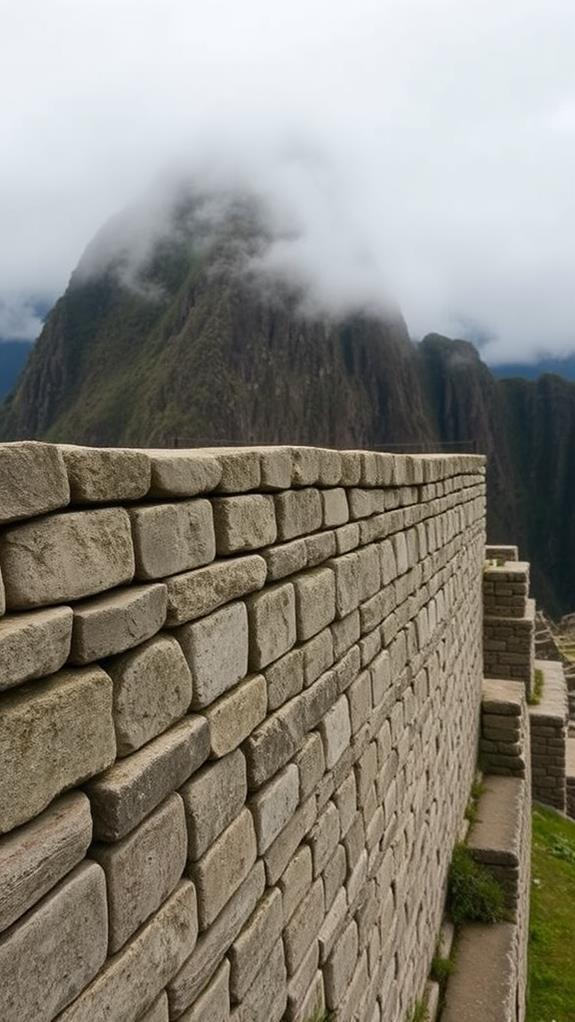
When you explore Machu Picchu, you'll witness an ancient engineering marvel that continues to astonish visitors and experts alike. This ancient Inca citadel showcases astonishing masonry skills through the ashlar technique, where stones are precisely cut to fit together without mortar. You'll notice over 150 buildings and more than 100 staircases carved from stone, demonstrating the Incas' ability to adapt to the steep terrain.
As you walk through Machu Picchu, pay attention to the trapezoidal shape of windows and doors. This design isn't just for aesthetics; it's a clever engineering solution for earthquake resistance, vital given the site's location near fault lines. You'll also encounter the Intihuatana stone, an important archaeological feature that served as an astronomical observatory, reflecting the Incas' deep understanding of celestial events.
Perhaps most impressive are the massive building stones weighing over 50 tons. These were transported uphill without wheels or pack animals, showcasing the extraordinary engineering capabilities of the Incas. As you explore, you'll gain a newfound appreciation for the ingenuity and skill of these ancient builders.
Hidden From Spanish Conquistadors
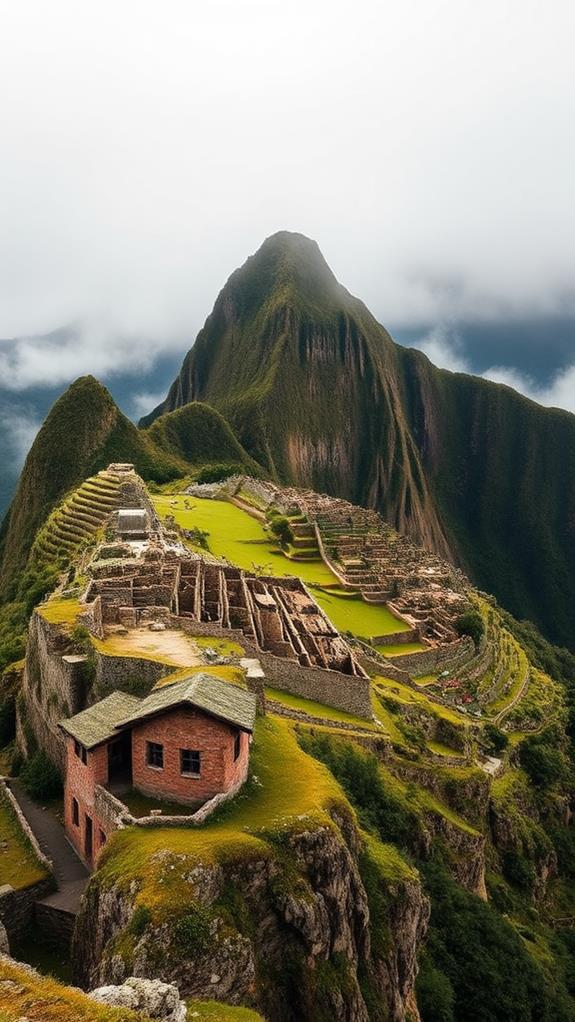
Machu Picchu's remote location in the Andes Mountains played an essential role in its preservation from Spanish conquistadors. You'll find that many of the site's ceremonial stones and structures remain untouched, a stark contrast to other Inca sites defaced during colonial times. This isolation allowed Machu Picchu to maintain its original integrity, offering you a glimpse into authentic Inca architecture and design that's rarely seen elsewhere.
Preservation Through Isolation
One of the most remarkable aspects of Machu Picchu's history is its preservation through isolation. You might wonder how this ancient Inca city managed to survive relatively intact for centuries. The answer lies in its remote location and rugged terrain. Situated over 7,000 feet above sea level in the Andes Mountains, Machu Picchu was shielded from Spanish conquest and exploitation.
Unlike many other Inca sites that were destroyed or repurposed during the invasion, Machu Picchu's difficult-to-access position kept it hidden from European attention. In fact, you won't find any mention of it in Spanish chronicles. The dense jungle surroundings also played a significant role in concealing the site, as nature reclaimed the area over time.
This isolation proved to be a blessing for modern archaeology. When Machu Picchu was rediscovered in 1911, it emerged as one of the best-preserved examples of Inca civilization. The site's structures and artifacts remained largely untouched, offering invaluable insights into ancient Inca life. Today, you can witness this remarkable preservation firsthand, thanks to the very isolation that kept Machu Picchu hidden for centuries.
Untouched Ceremonial Stones
The isolation that preserved Machu Picchu also safeguarded its most sacred features: the ceremonial stones. Unlike other Inca sites that fell victim to Spanish conquistadors, Machu Picchu's remote location in the Andes Mountains kept its spiritual elements intact. You'll find these untouched stones serving as a demonstration of the Inca civilization's architectural ingenuity and deep connection to spirituality and astronomy.
At the heart of Machu Picchu's ceremonial landscape lies the Intihuatana stone, a vital tool for ritual and astronomical observations. This stone, along with others scattered throughout the site, offers invaluable insights into Inca beliefs and practices.
| Ceremonial Stone Features | Significance |
|---|---|
| Untouched condition | Authentic representation |
| Precise craftsmanship | Architectural skill |
| Astronomical alignment | Celestial knowledge |
| Ritual purpose | Spiritual importance |
| Original location | Historical context |
These ceremonial stones provide a unique window into the past, allowing you to experience Machu Picchu as the Inca did centuries ago. Their preservation is a rare gift, offering unparalleled opportunities to study and appreciate the sophistication of Inca culture. As you explore the site, you'll witness firsthand the enduring legacy of this remarkable civilization.
Astronomical Significance
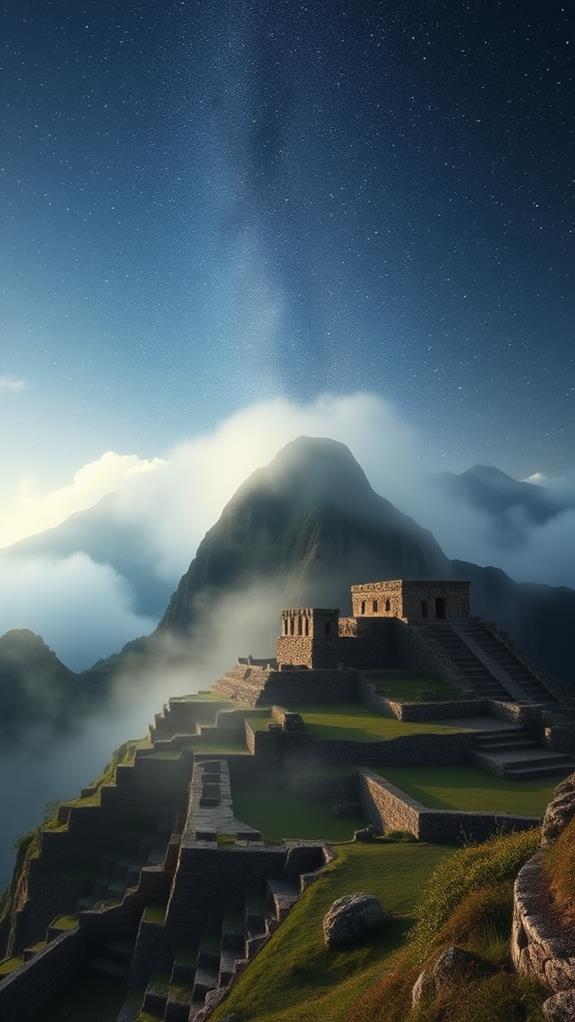
At the heart of Machu Picchu's design lies a profound astronomical significance. You'll find that this ancient Inca city served as an astronomical observatory, with structures strategically aligned to track celestial events. The Intihuatana stone, meaning "to tie up the sun" in Quechua, played an essential role in monitoring solar cycles. This ritual stone, along with the Temple of the Sun, was positioned to align with the sun's position during solstices and equinoxes.
As you explore Machu Picchu, you'll notice how its layout incorporates terraces and buildings that follow the sun's movement. This alignment isn't just for show; it had significant agricultural implications, helping the Incas plan their crop cycles. The site features multiple observation points where priests and astronomers could monitor celestial bodies, influencing both agricultural and ceremonial planning.
Archaeological studies suggest that Machu Picchu wasn't just a royal retreat. It's likely that religious ceremonies linked to astronomical phenomena took place here. The Inca culture's advanced understanding of astronomy is evident in every aspect of the site's design, showcasing their deep connection to the cosmos and its impact on their daily lives.
Earthquake-Resistant Architecture
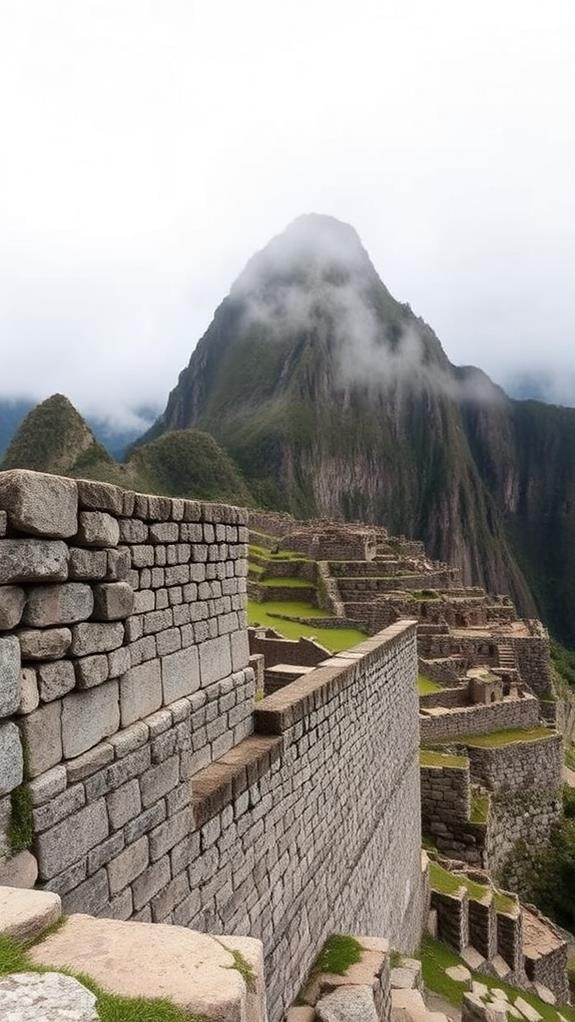
Perched atop a mountain ridge, Machu Picchu's endurance through centuries of seismic activity isn't mere chance. The Inca's advanced geological understanding led them to develop remarkable earthquake-resistant architecture that's still evident today. You'll notice the site's unique features, like trapezoidal doors and inward-sloping walls, which aren't just aesthetically pleasing but essential for structural stability.
The Incas employed the ashlar technique, a method of fitting stones tightly without mortar. This ingenious approach gives the structures flexibility during earthquakes, allowing them to absorb shocks without crumbling. You might be surprised to learn that Machu Picchu sits near two major fault lines, making its resilience even more impressive.
The ancient engineers didn't stop there. They built structures on solid rocky outcrops, creating a foundation that resists ground movement. This careful planning has paid off, as Machu Picchu has withstood numerous earthquakes throughout history. As you explore the site, you're witnessing not just an archaeological wonder, but a demonstration of Inca engineering prowess in the face of nature's most powerful forces.
Unique Biodiversity Hotspot
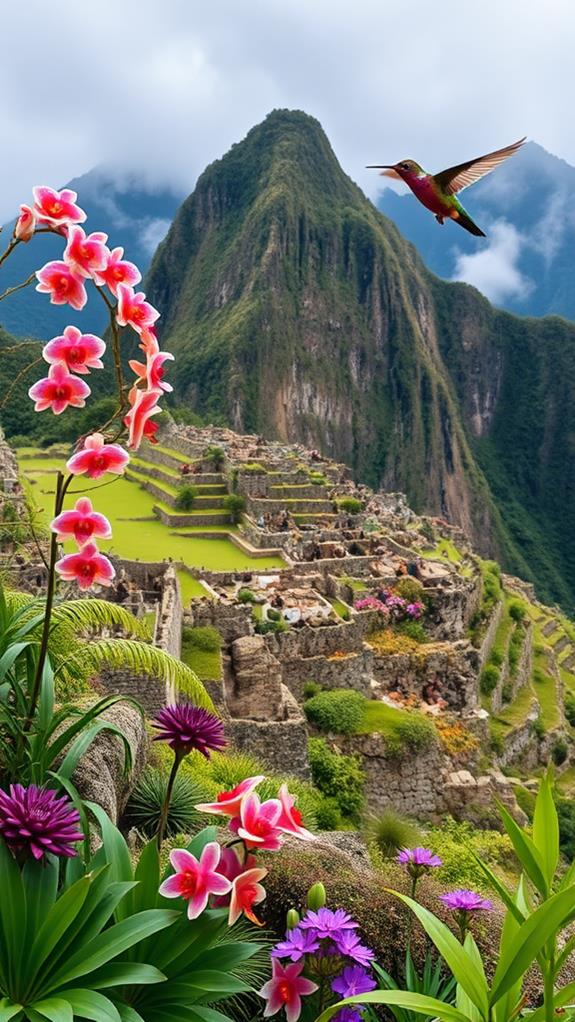
Beyond its architectural marvels, Machu Picchu boasts a unique ecological treasure. You'll find this ancient Incan city nestled within a cloud forest, characterized by high humidity and distinctive climatic conditions. These factors contribute to Machu Picchu's status as a biodiversity hotspot, hosting an impressive array of plant and animal species.
As you explore the area, you'll encounter a remarkable variety of wildlife. The region is home to over 420 bird species, including the majestic Andean condor. For plant enthusiasts, Machu Picchu's ecosystems showcase more than 200 orchid species, highlighting the site's floristic diversity.
Here's a breakdown of Machu Picchu's ecological significance:
| Category | Feature | Significance |
|---|---|---|
| Climate | Cloud forest | Unique conditions |
| Fauna | 420+ bird species | Rich biodiversity |
| Flora | 200+ orchid species | Botanical importance |
| Ecosystems | Andean & Amazonian | Conversion zone |
| Conservation | Archaeological & ecological | Habitat protection |
Machu Picchu's conservation efforts extend beyond preserving its archaeological heritage. By protecting these ecosystems, you're supporting the habitats of numerous species that call this area home. This blend of Andean and Amazonian influences creates a truly unique environment, making Machu Picchu not just a historical wonder, but an ecological marvel as well.
Artifact Repatriation Controversy

While Machu Picchu's architectural and ecological wonders captivate visitors, a contentious debate surrounds the site's artifacts. You might not know that thousands of Inca artifacts, taken by Hiram Bingham during his 1911 expedition, have been at the center of a long-standing repatriation controversy. These artifacts were sent to Yale University for research and display, sparking a legal dispute between the institution and Peru.
Yale claimed ownership of the artifacts, while Peru insisted they were only on loan. This disagreement highlights broader ethical concerns about cultural heritage items taken during colonial periods. After years of negotiations, Yale agreed in 2012 to return a significant portion of the artifacts to Peru. However, the complete repatriation remains a contentious issue.
Many of the returned artifacts are now displayed in the Machu Picchu Museum in Aguas Calientes, enhancing the site's cultural narrative. This controversy serves as a reminder of the complex issues surrounding ownership and repatriation of cultural heritage. As you explore Machu Picchu, you'll now appreciate the journey these artifacts have taken and their significance to Peru's cultural identity.
Are There Any Connections Between Chinchillas and Machu Picchu?
Chinchillas and Machu Picchu may seem unrelated, but both hail from the Andes Mountains of South America. These tiny, fluffy creatures share their origins with the ancient Incan civilization that built Machu Picchu. Discovering their history is one of the fascinating facts about chinchillas you missed, linking nature and culture in surprising ways.
Sustainable Tourism Challenges
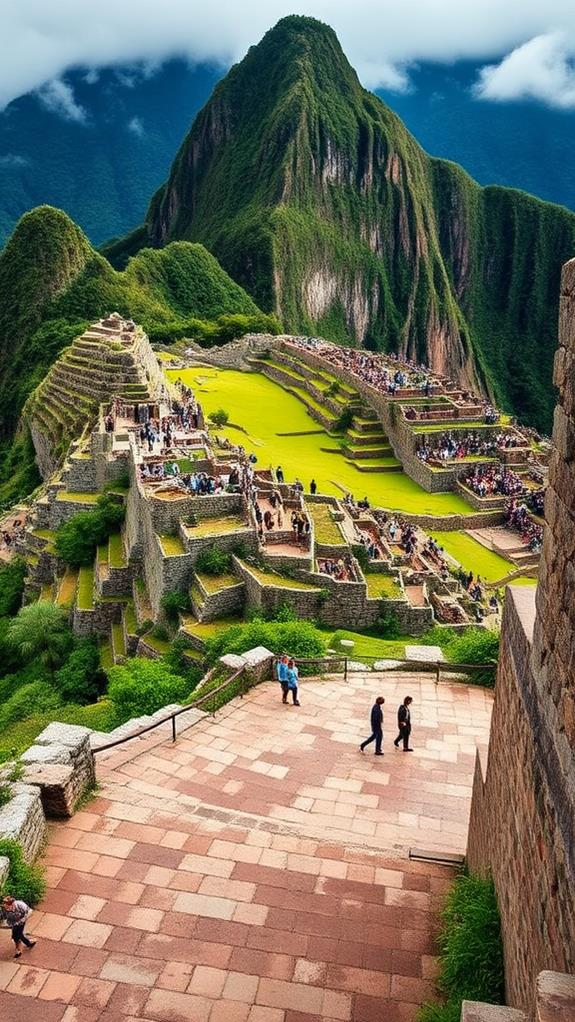
You'll find that Machu Picchu faces significant challenges in managing its visitor capacity, with over a million tourists flocking to the site each year. To mitigate environmental impacts, the Peruvian government has implemented daily visitor caps and promotes eco-friendly practices in nearby areas. Local communities are increasingly involved in sustainable tourism initiatives, helping to preserve the site's cultural heritage while benefiting from the economic opportunities tourism brings.
Visitor Capacity Management
As a victim of its own popularity, Machu Picchu faces significant challenges in managing visitor capacity. You might be surprised to learn that over 1 million people flock to this ancient Incan city annually. To combat overcrowding and protect the site's integrity, Peru's Ministry of Culture has implemented a strict daily entry system. This measure caps visitors at approximately 2,500 per day, helping to preserve the archaeological site for future generations.
If you're planning a trip, be aware that the peak tourist season runs from June to August. During these months, visitor caps are especially vital to maintain safety and the site's atmosphere. To enhance your experience and contribute to sustainable tourism practices, consider joining a guided tour. These smaller group sizes help minimize wear on the ancient structures and natural environment.
Conservation efforts are ongoing, with discussions about adopting new technologies like advanced ticketing systems. These innovations aim to better manage visitor flow and optimize your experience at this awe-inspiring wonder. By respecting these measures, you're playing a part in preserving Machu Picchu's magic for years to come.
Environmental Impact Mitigation
Frequently, the allure of Machu Picchu's ancient wonders overshadows the complex environmental challenges it faces. As a UNESCO World Heritage Site, it's essential to balance tourism with conservation efforts. You might not realize the extent of measures taken to protect this iconic destination.
Here's what you should know about environmental impact mitigation at Machu Picchu:
- Limited daily visitor numbers: Strict regulations cap the number of tourists allowed each day to minimize erosion and environmental degradation.
- Designated walking paths: Authorities have established specific routes to concentrate foot traffic and protect surrounding flora and fauna.
- Ecological guidelines: Visitors must follow rules designed to reduce human impact on the delicate cloud forest ecosystem.
- Regular environmental impact assessments: Experts conduct ongoing evaluations to monitor and manage tourism's effects on the site.
These sustainable tourism practices aim to preserve Machu Picchu's archaeological and natural integrity. The Peruvian government collaborates with organizations like the WWF to implement responsible tourism strategies. By following these measures, you're contributing to the site's long-term conservation while still experiencing its breathtaking beauty. Remember, your visit impacts this ancient wonder, so tread lightly and respect the guidelines in place.
Local Community Involvement
Local communities are the unsung heroes in Machu Picchu's sustainable tourism efforts. You'll find that many residents are actively engaged in guiding services and local businesses, providing eco-friendly accommodation and food options. These community-led initiatives promote responsible tourism practices, emphasizing the preservation of cultural heritage and environmental conservation in the Machu Picchu region.
In 2018, the Peruvian government and local organizations launched a program to educate you and other tourists about cultural norms. This initiative aims to enhance cultural respect and minimize the ecological impact of your visit. You'll also notice that the local population has been participating in reforestation projects and conservation efforts, directly contributing to the protection of the surrounding cloud forest ecosystem.
When you visit, you might have the opportunity to attend community festivals and events. These gatherings are designed to educate you about Inca traditions and local culture, fostering a deeper connection between you and the indigenous heritage of the region. By engaging with these local initiatives, you're supporting sustainable tourism and helping to preserve Machu Picchu's unique cultural and natural landscape for future generations.
Frequently Asked Questions
What Are 5 Interesting Facts About Machu Picchu?
You'll be fascinated to learn these interesting facts about Machu Picchu:
- It's an astronomical observatory, with the Intihuatana stone precisely aligning with celestial events.
- The site boasts over 100 stone staircases, showcasing Incan engineering prowess.
- It remained hidden from Spanish conquerors, preserving its structures.
- Machu Picchu means "Old Peak" in Quechua, the Incan language.
- It's both a UNESCO World Heritage Site and one of the New Seven Wonders of the World, attracting over a million visitors annually.
What Is Unknown About Machu Picchu?
You might be surprised by how much remains unknown about Machu Picchu. Its original purpose still puzzles experts, with theories ranging from a royal estate to a religious retreat. Many areas of the site are unexplored, potentially hiding archaeological secrets. The exact construction methods used for its precisely fitted stonework continue to baffle researchers. The true significance of the Intihuatana stone in Inca spirituality is also debated. Even the site's discovery narrative is contested, challenging the "lost city" myth.
What Is the Extra Information About Machu Picchu?
You might be surprised to learn that Machu Picchu holds more secrets than you thought. Beyond its well-known features, the site boasts an intricate water management system with 16 fountains and numerous channels. You'll find over 100 staircases, some with over 100 steps each. The site's precise alignment with astronomical events is remarkable. Notably, many structures were built to withstand earthquakes, using techniques like trapezoidal doors and windows. These engineering marvels showcase the Incas' advanced knowledge and skills.
How Many Flights of Stairs Is Machu Picchu?
You'll find over 100 separate flights of stairs at Machu Picchu. These aren't just any stairs; they're intricately carved from stone slabs and designed to handle the site's steep terrain. You'll notice their trapezoidal shapes, which aren't just for looks—they help protect against earthquakes. As you explore, you'll see how the stairs vary in size, showcasing the Incas' skill in adapting to their environment. These staircases connect the citadel's residential, agricultural, and ceremonial areas, highlighting the Incas' advanced engineering techniques.





